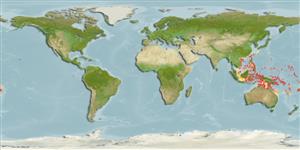Common names from other countries
>
Gobiiformes (Gobies) >
Gobiidae (Gobies) > Gobiinae
Etymology: Trimma: Greek, trimma, -atos = something crushed (Ref. 45335); nasa: Name derived from the English word 'nasal', a bar descending gtom the front of many medieval helmets to protect the nose, in allusion to the snout stripe; noun in apposition..
More on author: Winterbottom.
Environment: milieu / climate zone / depth range / distribution range
Sinh thái học
Biển gần đáy; Mức độ sâu 0 - 41 m (Ref. 55345), usually 0 - 20 m (Ref. 55345). Tropical
Western Pacific: Solomon Islands, Papua New Guinea, Indonesia, Vanuatu, Fiji, New Caledonia, Australia, the Philippines, and Palau.
Bộ gần gũi / Khối lượng (Trọng lượng) / Age
Maturity: Lm ? range ? - ? cm
Max length : 2.3 cm SL con đực/không giới tính; (Ref. 55345); 2.0 cm SL (female)
Các tia vây lưng cứng (tổng cộng) : 7; Các vây lưng mềm (tổng cộng) : 8; Tia cứng vây hậu môn: 1; Tia mềm vây hậu môn: 7 - 9. Diagnosis: Predorsal scales and a bony interorbital about pupil diameter in width. Second dorsal spine elongated. Fifth pelvic fin ray branched dichotomously once and 50-60% of the fourth. Scales on cheek absent; one or two scales on the upper opercle; usually 4-5 rows of scales anterior to the pelvic fin base. A large spot over the hypural region of the caudal peduncle; a dark area along the side of the body caused by peritoneal pigmentation. In all specimens, but that from Palau and New Caledonia, there is a thin, dark stripe from the upper lip to the mid region of the interorbital when preserved (white in life), a broad rounded ridge on the snout and anterior interorbital region, and a nasal sac with a tubular anterior opening and a pore-like posterior opening with a raised rim (Ref. 55345); characterized further by having longitudinal scale series 23-24; predorsal scales 5-7; depth of body 4.3-4.6 in SL (Ref. 90102).
Cryptobenthic, epibenthic. Collected on drop-offs, either sloping or vertical with caves. Apparently tends to congregate in loose schools close to the shelter of caves and sea fans, to which they retreat when approached, and seem to be most abundant at about 20 meter depth range. Often form mixed schools with Trimma tevegae (Ref. 55345).
Life cycle and mating behavior
Maturities | Sự tái sinh sản | Spawnings | Egg(s) | Fecundities | Ấu trùng
Winterbottom, R., 2005. Two new species of the Trimma tevegae species group from the Western Pacific (Percomorpha: Gobiidae). aqua, J. Ichthyol. Aquat. Biol. 10(1):29-38. (Ref. 55345)
IUCN Red List Status (Ref. 130435)
CITES (Ref. 128078)
Not Evaluated
Threat to humans
Harmless
Human uses
Các công cụ
Special reports
Download XML
Các nguồn internet
Estimates based on models
Preferred temperature (Ref.
115969): 26.5 - 29.1, mean 28 (based on 330 cells).
Phylogenetic diversity index (Ref.
82804): PD
50 = 0.5000 [Uniqueness, from 0.5 = low to 2.0 = high].
Bayesian length-weight: a=0.01023 (0.00477 - 0.02194), b=3.02 (2.84 - 3.20), in cm Total Length, based on LWR estimates for this (Sub)family-body shape (Ref.
93245).
Thích nghi nhanh (Ref.
120179): Chiêù cao, thời gian nhân đôi của chủng quần tối thiểu là dưới 15 tháng (Preliminary K or Fecundity.).
Fishing Vulnerability (Ref.
59153): Low vulnerability (10 of 100).
